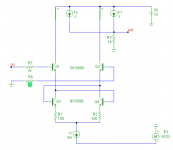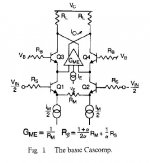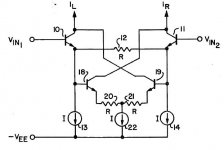cross-quad
Hi Scott,
Indeed, it's an interesting topology, but I've never explored this one in detail, mainly because D. Self warned us about the 'negative (input) conductances inherent in its operation'. How serious is this warning?
Cheers,
Edmond.
scott wurcer said:For linearizaion, don't forget the cross-quad. It is worth noting that you do not need 4 matched devices but two pairs should work fine.
Hi Scott,
Indeed, it's an interesting topology, but I've never explored this one in detail, mainly because D. Self warned us about the 'negative (input) conductances inherent in its operation'. How serious is this warning?
Cheers,
Edmond.
john curl said:Looks interesting, Scott.
Sure, very interesting comment too!
scott wurcer said:For linearizaion, don't forget the cross-quad. It is worth noting that you do not need 4 matched devices but two pairs should work fine.
Thanks Scott.
I haven’t looked inside the MAT04 before, so this was very interesting.
Edmond, D. Self is warning about a lot of different things.
Re: cross-quad
Now would they put something on a data sheet that didn't work? 🙂 There are issues but I think they are managable without too much pain.
Edmond Stuart said:
Hi Scott,
Indeed, it's an interesting topology, but I've never explored this one in detail, mainly because D. Self warned us about the 'negative (input) conductances inherent in its operation'. How serious is this warning?
Cheers,
Edmond.
Now would they put something on a data sheet that didn't work? 🙂 There are issues but I think they are managable without too much pain.
D. Self
True! Even in cases where it wasn't necessary, for example the alleged 'bat wing' x-fer function of MOSFET output stages, which was solely based on erroneous spice models.
Cheers,
Edmond.
stinius said:[snip]
Edmond, D. Self is warning about a lot of different things.
True! Even in cases where it wasn't necessary, for example the alleged 'bat wing' x-fer function of MOSFET output stages, which was solely based on erroneous spice models.
Cheers,
Edmond.
Re: Re: cross-quad
OK, manageable without too much pain. Nevertheless, I still stick to an AD797 for my latest power amp design (or maybe a LME49710, if you don't mind 🙂)
Cheers,
Edmond.
scott wurcer said:Now would they put something on a data sheet that didn't work? 🙂 There are issues but I think they are managable without too much pain.
OK, manageable without too much pain. Nevertheless, I still stick to an AD797 for my latest power amp design (or maybe a LME49710, if you don't mind 🙂)
Cheers,
Edmond.
john curl said:You, you, and you. You know better than to ask me such a thing.
Thank you, thank you and thank you. I thought you knew better as well.
john curl said:How about TANH Scott, any easy examples?
I posted one here a couple of weeks ago. I think it used about $1.50 in parts. The matching is a problem but as an experiment I would pull parts off a strip and wrap them with a little adhesive backed copper grounding tape in groups of 5. As a product it really is only an IC technique. The cross-quad looks promising as it has been used in a couple of discrete amplifiers, IIRC.
Re: cross-quad
Again this is sort of a positive feedback technique. Looking into the lower pair you have a derived "short". Which can look like a negitive impedance under some circumstances i.e. it makes a nice oscillator in Barrie's first V to F. 🙂
Edmond Stuart said:
Hi Scott,
Indeed, it's an interesting topology, but I've never explored this one in detail, mainly because D. Self warned us about the 'negative (input) conductances inherent in its operation'. How serious is this warning?
Cheers,
Edmond.
Again this is sort of a positive feedback technique. Looking into the lower pair you have a derived "short". Which can look like a negitive impedance under some circumstances i.e. it makes a nice oscillator in Barrie's first V to F. 🙂
Current source/sink IC
I just received the 5/21/09 Electronic Design which features the new LT3092 monolithic full-floating current source/sink IC. It can source/sink up to 200 mA with Vin-Vout max of 40V. With so much of audio dependent on diff pairs, I wonder how this chip would stack up against the discrete designs.
REF: ED Online 21157
I just received the 5/21/09 Electronic Design which features the new LT3092 monolithic full-floating current source/sink IC. It can source/sink up to 200 mA with Vin-Vout max of 40V. With so much of audio dependent on diff pairs, I wonder how this chip would stack up against the discrete designs.
REF: ED Online 21157
Re: Current source/sink IC
Hi Chuck,
If you read the material carefully, you will find that it is great as a DC source but that the dynamic impedance and performance deteriorates rapidly with frquency, and that all kinds of 'band aids' are shown to prop it up at AC. And some of the more interesting areas (for audio) are conspicuously blank in the data sheet. Nice, but no thanks. My 2cts worth.
Jan Didden
chascode said:I just received the 5/21/09 Electronic Design which features the new LT3092 monolithic full-floating current source/sink IC. It can source/sink up to 200 mA with Vin-Vout max of 40V. With so much of audio dependent on diff pairs, I wonder how this chip would stack up against the discrete designs.
REF: ED Online 21157
Hi Chuck,
If you read the material carefully, you will find that it is great as a DC source but that the dynamic impedance and performance deteriorates rapidly with frquency, and that all kinds of 'band aids' are shown to prop it up at AC. And some of the more interesting areas (for audio) are conspicuously blank in the data sheet. Nice, but no thanks. My 2cts worth.
Jan Didden
Re: cross-quad
Might make it hard to use in an input stage unless it's buffered. There are also issues with driving it hard/transient response so it is probably better left buried on the interior of the circuit.
Edmond Stuart said:Hi Scott,
A quick and dirty sim reveals that the circuit below gets unstable if rb > 330 Ohms. So, indeed, the stability issue is manageable if the impedances at the input are kept sufficiently low.
Cheers,
Edmond.
Might make it hard to use in an input stage unless it's buffered. There are also issues with driving it hard/transient response so it is probably better left buried on the interior of the circuit.
scott wurcer said:There is also the cascomp stage related to the crossquad which has fewer problems because it is a feedforward technique. It originated in Tek scope open-loop verticle amplifiers, I think.
Prof. Hawksford, 1981, that's where I have originally seen the cross-quad and cascomp stages ideas. Some previous work could exist, though.
http://www.essex.ac.uk/csee/research/audio_lab/malcolmspubdocs/J4 Distortion correction circuits.pdf
EDIT: For those without IEEE library access, Gilbert's article on multi-tanh principle is available here: http://iroi.seu.edu.cn/jssc9899/33ssc98/33ssc01/pdf/33ssc01-gilbert.pdf BTW, I find very elegant that Gilbert is quoting Schmook and his 1975 work.
Barrie has taken some bitter flak on the naming of the Gilbert cell which I think is unjustified. Anyway here is Bob Blaushield's version of open-loop linearization. If you Google patent for Pat Quinn's original 1979 patent you can surf the references for these ideas all day.
Attachments
- Status
- Not open for further replies.
- Home
- Amplifiers
- Solid State
- John Curl's Blowtorch preamplifier



